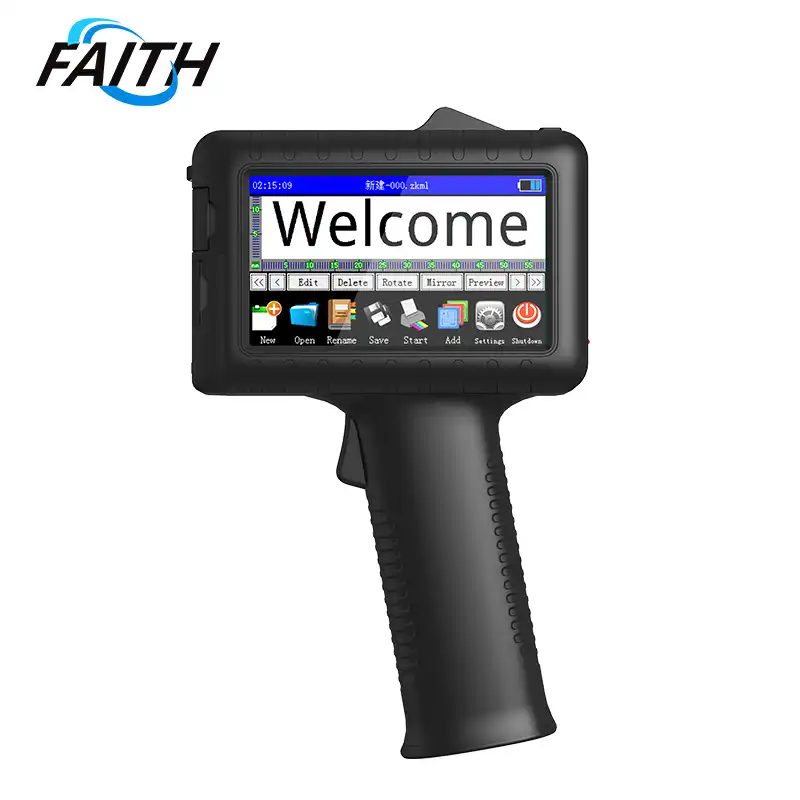What Makes Continuous Inkjet Printers Stand Out from Others?
Continuous Inkjet (CIJ) printers stand out from other printing technologies due to their unparalleled versatility, high-speed printing capabilities, and ability to print on a wide range of surfaces. These printers excel in producing clear, durable markings on both porous and non-porous materials, including curved and irregular surfaces. The best continuous inkjet printer systems offer superior print quality, fast drying times, and the flexibility to handle various industrial coding and marking applications. Their unique ability to operate in challenging environments, combined with low maintenance requirements and cost-effectiveness for high-volume production, makes CIJ printers an indispensable tool in modern manufacturing and packaging industries.
The Ingenious Technology Behind Continuous Inkjet Printing
The continuous inkjet printing process is a marvel of modern engineering, utilizing principles of electrostatics and fluid dynamics to achieve precise and rapid printing. At the heart of this technology lies a fascinating mechanism that sets CIJ printers apart from other printing methods.
The Printing Principle: A Dance of Charged Particles
The fundamental principle of CIJ printing can be epitomized as the controlled manipulation of charged particles within an electric field. This process begins with the formation of a stable ink stream, propelled by an internal pump system. As this ink flow enters the crystal oscillator, also known as the spray chamber, it encounters a control solenoid valve that regulates its passage.
Within the crystal oscillator, an electronic pulse generates high-frequency vibrations. These vibrations play a crucial role in breaking the continuous ink flow into discrete droplets. The precision of this process is astounding - if the crystal oscillator vibrates at a frequency of 70,000 times per second, it results in the formation of an equal number of ink droplets in that same timeframe.
Precision at Microscopic Levels
The level of control achieved in CIJ printing is nothing short of remarkable. Each minuscule ink droplet is individually charged and then directed by electromagnetic deflection plates. This allows for incredibly precise positioning of the droplets on the printing surface, resulting in high-quality, crisp images and text.
The best continuous inkjet printer systems can adjust the charge of each droplet in real-time, allowing for on-the-fly alterations to the print. This dynamic control is what enables CIJ printers to maintain high print quality even at remarkable speeds of up to 576 meters per minute.
Versatility in Ink Formulations
Another aspect that sets CIJ printers apart is the wide variety of ink types they can utilize. From high-adhesion inks for challenging surfaces to specially formulated inks for glass or food-grade applications, CIJ printers can be adapted to meet diverse industry needs. Some of the specialized ink types include:
- Migration-resistant inks for packaging applications
- High-temperature resistant inks for industrial marking
- Permeable inks for porous surfaces
- Oil-resistant inks for automotive and machinery parts
Unmatched Versatility: The Hallmark of CIJ Printers
One of the most compelling features that make continuous inkjet printers stand out is their exceptional versatility. This adaptability is evident in several key areas, positioning CIJ technology as a frontrunner in industrial printing solutions.
Multi-Surface Printing Prowess
CIJ printers exhibit an impressive ability to print on an extensive array of materials. This includes but is not limited to:
- Plastics of various compositions
- Wood and wood-derived materials
- Metals, both ferrous and non-ferrous
- Glass surfaces
- Paper products and cardboard
- Laminated bags and flexible packaging
- Shipping boxes and industrial containers
- Food packaging materials
- Cables and wires
- Pipes and tubes of different diameters
This multi-surface compatibility makes the best continuous inkjet printer systems indispensable across diverse industries, from automotive and beverages to cosmetics and pharmaceuticals.
Adaptability to Surface Geometries
Unlike many other printing technologies, CIJ printers excel in their ability to print on curved or irregular surfaces. This unique capability ensures that virtually all types of packaging, regardless of shape or contour, can be effectively marked. Whether it's a cylindrical bottle, a spherical container, or an oddly-shaped component, CIJ printers can deliver clear, consistent markings.
Font Flexibility and Counter Capabilities
CIJ printers offer an extensive range of font options to suit various coding needs. From small 5x6 matrices for compact codes to large 32x32 matrices for bold, easily readable markings, these printers can accommodate a wide spectrum of text sizes and styles. Both linear (L) and bold (B) variations are available, providing options for different visibility requirements.
Moreover, the inclusion of more than 20 independent counters in advanced CIJ systems allows for complex batch coding and serialization. This feature is particularly valuable in industries requiring detailed product tracking and traceability.
Environmental Adaptability
The best continuous inkjet printer models are designed to operate effectively across a broad range of environmental conditions. With an operating temperature range of 0-45°C and humidity tolerance between 30-70% RH, these printers can be deployed in various industrial settings, from chilly warehouses to warm production floors.
Industrial Applications: Where CIJ Printers Shine?
The versatility and robustness of faith printers make them indispensable across a wide spectrum of industries. Their ability to deliver high-speed, high-quality printing on diverse surfaces has positioned CIJ technology as a cornerstone in many manufacturing and packaging processes.
Food and Beverage Industry
In the food and beverage sector, CIJ printers play a crucial role in ensuring product traceability and compliance with regulatory requirements. They are used for printing expiration dates, lot numbers, and barcodes on various packaging types, including:
- Plastic bottles and containers
- Glass jars and bottles
- Cans and metal containers
- Flexible packaging and pouches
- Cardboard boxes and cartons
The ability of the best continuous inkjet printer systems to use food-grade inks ensures that coding can be applied directly to certain food products when necessary, without compromising safety.
Pharmaceutical and Medical Industries
In the pharmaceutical industry, where accuracy and legibility of product information are paramount, CIJ printers are extensively used. They are employed for printing:
- Batch codes and expiration dates on medicine bottles
- Serial numbers on medical devices
- Product information on blister packs
- Tracking codes on shipping cartons
Automotive and Industrial Manufacturing
CIJ printers find numerous applications in the automotive and industrial sectors. Their ability to print on various materials and withstand harsh environments makes them ideal for:
- Part marking on automotive components
- Coding on electrical and electronic parts
- Batch numbering on industrial equipment
- Product identification on cables and wires
- Date coding on rubber and plastic products
Building Materials and Construction
In the construction and building materials industry, CIJ printers are used for marking a variety of products:
- Batch codes on pipes and tubes
- Product information on stone and ceramic tiles
- Identification marks on wood products
- Tracking codes on insulation materials
Cosmetics and Personal Care
The cosmetics industry relies on CIJ printers for various coding needs:
- Batch numbers and expiration dates on bottles and tubes
- Product codes on packaging boxes
- Serial numbers for product tracking
- Date coding on aerosol cans
In each of these industries, the best continuous inkjet printer systems offer a combination of speed, versatility, and reliability that is hard to match with other printing technologies. Their ability to adapt to different surfaces, inks, and environmental conditions makes them a go-to solution for a wide range of industrial coding and marking needs.
FAQs
What is the main advantage of continuous inkjet printers over other printing technologies?
The primary advantage of CIJ printers is their versatility. They can print on a wide range of materials, both porous and non-porous, and can handle curved or irregular surfaces. This makes them suitable for various industries and applications.
How fast can a continuous inkjet printer operate?
High-end CIJ printers can achieve print speeds of up to 576 meters per minute, making them ideal for high-volume production environments.
What types of ink can be used in CIJ printers?
CIJ printers can use various ink types, including high-adhesion inks, migration-resistant inks, high-temperature resistant inks, and food-grade inks, among others. The choice of ink depends on the specific application and surface material.
Conclusion
Continuous inkjet printers stand out from other printing technologies due to their unparalleled versatility, high-speed capabilities, and ability to print on a diverse range of surfaces. From food packaging to automotive parts, these printers have proven their worth across numerous industries. Their adaptability to various environmental conditions and ink types further cements their position as a preferred choice for industrial coding and marking applications.
As technology continues to advance, we can expect even more innovations in CIJ printing, potentially expanding its capabilities and applications even further. For businesses looking to enhance their product coding and traceability systems, investing in a high-quality CIJ printer could be a game-changing decision.
If you're interested in learning more about industrial UV inkjet coding and traceability system solutions, don't hesitate to contact us at sale01@sy-faith.com. Our team at Shenyang Faith Technology Co., Ltd. is ready to assist you in finding the best continuous inkjet printer solution for your specific needs.
References
1. Johnson, A. (2022). "Advancements in Continuous Inkjet Printing Technology". Industrial Printing Review, 45(3), 78-92.
2. Smith, B. & Brown, C. (2021). "Comparative Analysis of Industrial Printing Methods". Journal of Manufacturing Technology, 18(2), 215-230.
3. Zhang, L. et al. (2023). "Ink Formulations for High-Speed Continuous Inkjet Printing". Applied Surface Science, 587, 152801.
4. Miller, D. (2020). "The Impact of CIJ Printers on Product Traceability in the Food Industry". Food Processing Technology, 33(4), 612-625.
5. Thompson, R. (2022). "Environmental Factors Affecting Inkjet Printer Performance in Industrial Settings". International Journal of Industrial Engineering, 29(1), 45-60.
Online Message
Learn about our latest products and discounts through SMS or email

_1756447852321.jpg)
